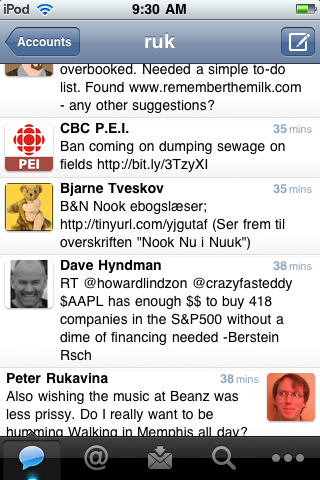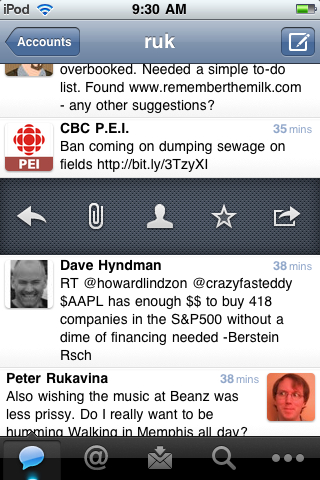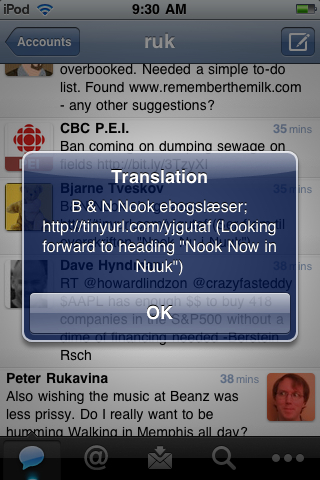I stumbled across a very helpful tool this afternoon while visiting the CBC website: the Master Planner from CBC Media Sales and Marketing is a web application that lets you explore the ratings and audience size of CBC programs by market and demographic.
If I enter “Charlottetown” as the “Market,” for example, “CBC News at Six” as the “Program,” “Fall 2009” as the “Season” and select “A2+” (short for “all viewers”) as the demographic, I learn that 23% of televisions in the Charlottetown market were watching the Compass, representing an estimated audience of 31,500.
Splitting this up demographically, in the “lucrative 18-24” demographic the rating is to 5.4% and in the “55+” demographic it’s 41.8%.
I think that means that “a lot more old people watch Compass.”
By contrast, The National has a 2.9% share and an estimated audience of 4,050, the Rick Mercer Report has a 3.8% share and an audience of 5,500 and the Sunday morning airing of Coronation Street has a 1.9% share and an audience of 2,880.
Looking across the country, Compass’ counterparts (assuming they’re all tagged CBC News at Six) have the following ratings share:
- Vancouver, 0.7%
- Edmonton, 0.45%
- Calgary, 0.6%
- Regina, 1.05%
- Winnipeg, 3.9%
- Toronto, 0.8%
- Montreal, 2.2%
- Halifax, 5.15%
- St. John’s/Cornerbrook, 10.4%
This means that 10,000 more people are watching the CBC News at Six in Prince Edward Island than are watching the CBC News at Six in Montreal (despite the fact that Montreal is, well, bigger).
By ratings, the ten most popular shows for the CBC Charlottetown market are:
- CBC News at Six (23.15%)
- CBC News at Five (8.9%)
- Jeopardy (6%)
- Coronation Street Primetime (5.3%)
- Hockey Night in Canada (5.3%)
- Wheel of Fortune (4.7%)
- Heartland (4%)
- Rick Mercer Report (3.8%)
- Nature of Things (3.6%)
- Figure Skating Championships (3.5%)
By contrast the most popular programs in the CBC Toronto market are:
- Jeopardy (4.3%)
- Hockey Night in Canada (4.2%)
- Harry Potter and the Order of the Phoenix (3.41%)
- Wheel of Fortune (3.38%)
- Rick Mercer Report (2.9%)
- Coronation Street Primetime (2.5%)
- Happy Feet (2.5%)
- Elf (2.3%)
- Ron James Show (2.3%)
- Best of Rick Mercer (2.1%)
Of those top 10 shows in Toronto, 3 are Hollywood movies, 2 are U.S. game shows, and 1 is a British soap. Only three are made-in-Canada: 2 Rick Mercers, a Ron James and the hockey.
So, it’s true what they say: lots of Prince Edward Islander’s watch Compass.
You gotta wonder about the Jeopardy and the Wheel of Fortune though. I guess running those imports five times a week is what lets the 5,000 Islanders watch the Nature of Things on Sunday nights?
My main out-of-home way of interacting with Twitter is through the Tweetie application on my iPod Touch. And one of my favourite features of Tweetie is its ability to automatically translate tweets from other languages. All I need to do is “swipe” the tweet in question, which calls up a set of icons; I click on the right-most one, click “Translate” and the tweet appears in English (or at least in Englishish) in a pop-up dialog:




Bonus tip: on an iPhone or iPod Touch you can take a screen shot by pressing the “sleep” button (on the top of the device) and the “home” button at the same time; the screen will flash briefly to show you that you’ve succeeded, and the next time you sync your device your screen shots will appear in iPhoto for download.
Soon after the school year started Oliver reported to me that he’d tried to access this website from one of the computers at Prince Street School and that he’d been blocked. I later heard from a friend with a spouse who teaches at a local high school that they’d run into a similar issue.
And so over the past few weeks I’ve been learning a lot about Internet filtering in Prince Edward Island schools.
Internet filtering is a touchy subject with me, as in my heart of hearts I’m a strict information libertarian. Filtering the Internet is an effort that’s both ultimately futile, and takes our collective eyes off the real issue, which is outfitting our children to be their own information filters.
At the same time I know that’s a rather Utopian vision of information society, that it’s an almost impossible political sell to the culturally and spiritually squeamish, and that without some sort of filtering there would likely be no Internet in schools at all. (I’ve also seen enough of the Internet’s seedier side to know that there are some things you can’t un-see, and I’m not sure what the answer to that is).
Which is all to say that I went into my “learning about Internet filters in schools” exercise with a mixture of open-minded curiousity and light moral indignation.
Here’s what I learned.
Back in the spring of 2007, the Province of PEI issued a tender for “the supply of a web filtering solution” (tender documents as a PDF). The “filtering solution” was to cover not only Prince Edward Island schools, but also computers within the public service and the health system; the successful bidder was a Guelph company called Netsweeper, not surprising as it was one of only two products that the tender pre-qualified (the other was Blue Coat).
Netsweeper’s content filtering methodology works, by their own description, as follows:
At the heart of the Netsweeper application resides an artificial intelligence engine that will categorise URLs in real-time based on actual website content.
When a user makes a request to the Internet, this request is intercepted and the URL is identified. The URL name is then sent to the Netsweeper Policy Server to determine what action is to be taken, meaning to allow or deny access at the site. If a user visits a website that is not in the local database, it is requested from the central database or the Content Naming Server (CNS). The CNS provides the information about the requested website to the Policy Server, which caches the information so as to be ready should the request ever be made again. This ensures that the Policy Server only has relevant URLs in its cache.
If the website requested by the end user is not in the CNS, the URL is sent to the categorisation engine that will download, scan and then categorise the page on demand. This category information will then be sent back through the chain to the Policy Server. This entire process happens in milliseconds, resulting in virtually no degradation in performance for the end user.
The categorisation system is also integrated with the Master CNS. As unknown URLs are found and categorised, the Master database is updated and will synchronise with all Policy Servers on a global level. Today, this central database consists of over 1 billion unique URL addresses.
On a local level, the Department of Education developed a list of Netsweeper categories to which access would be denied (shown on this document in red), the end result being that when a teacher or student in a PEI school uses their browser to access a URL, the URL they entered is first handled by Netsweeper which determines the category it falls in, determines whether that category is on the “denied” list, and, depending on what it finds, either allows or denies access.
You can get a sense of how the categorization process works using the Test a Site tool on Netsweeper’s website. This site, for example, is categorized under:
- Journals and Blogs
- Arts & Culture
- General News
- Sales
- Sports
- Travel
- Portals
With the exception of “sales,” “sports” and “portals” that’s a relatively accurate categorization (sports?!).
None of the categories appear on the list of denied categories for PEI schools, so, in theory, this site should be available in schools.
And, sure enough, this morning I was able to confirm that, in fact, it is available: the technology coordinator at Prince Street School allowed me to test this in the school’s computer lab, and the site was accessible without issue. This means that either something has changed since Oliver originally tried earlier in the year, there was a non-related technical issue when he tried, or simply that he entered the address incorrectly.
Irony aside, it’s good to know more about Internet filtering is set up inside schools; while I remain convinced that it’s wrong-headed, at least it’s not at least slightly more transparent.
This chair, part of an exhibition at the Danish Design Centre, signifies to me everything that is wrong with museums. I mean, it’s a chair: to understand it you have to sit in it. Otherwise, what’s the point.

Two years ago I wrote about how to save the nightly Compass video onto your computer using the free VideoLAN application.
Today I added some automation to the process so that, if you have an iPod, you can have your computer automatically grab Compass and dump it into iTunes for syncing. Here’s what you need:
- First, make sure you have VideoLAN installed on your Mac. My script assumes you have it installed in your main Applications folder. Note that I’ve only got this working on VLC version 0.8.6 – later versions fail.
- Next, grab the compass4ipod.sh script, and save it somewhere on your Mac.
- Open the Terminal application (it’s under Applications/Utilities), and move to the directory where you save the compass4ipod.sh script. For example, if you save it on your Desktop, then just cd ~/Desktop.
- Run the script: bash compass4ipod.sh
The script saves Compass in “real time,” so if you’re saving 15 minutes of Compass it will take 15 minutes to run. When it’s done, you should end up with the latest Compass in the Movies folder of your iTunes, ready for syncing to your iPod.


I welcome any reports of issues you run into trying to make this work.
Update: I’ve prepared a standalone Mac OS X application that, as long as you have VideoLAN installed on your Mac, should allow you to do all of the above in one click.
Update: I’ve added a note about the fact that only VLC version 0.8.6 appears to work with this script; later versions fail.
I’ve created an Internet Archive page for my Applications vs. Capabilities talk from Access 2009. You can now feel free to integrate the video into you homebrew rock videos, etc. as the 500MB of original video is now available in all its glory.
Here’s a great idea from the Prince Edward Island Provincial Library: Book Club in a Bag, described as:
Book Club in a Bag is a service for the use of book clubs wanting the convenience of a pre-packaged bag complete with 10 copies of a book, a discussion guide and suggested questions and a sign-out sheet for the group leader. We have many titles to choose from, including several that are also suitable for teen clubs.
There are currently 124 books available in English under this program.
While I was traveling in September, Starbucks opened up shop in the Tweel building at the corner of Kent and University in downtown Charlottetown. While we’ve had pretend “proudly serving Starbucks” outlets in several locations on the Island, this is the first bona fide Starbucks here and given my late-to-the-party love of a good cappuccino, and the fact that Starbucks is on my way to work each morning, I’m forced to decide whether this is a good thing or a bad thing.
By gut reaction is bad thing, but, to be honest, I’m not sure whether that’s my head talking or years worth of “local = good, multinational = bad” rhetoric coursing through my heart.
Starbucks just feels evil; I’m not actually sure whether it is evil.
I thought about this on Saturday while Oliver were on the way to Canadian Tire to buy a replacement flap for our ailing upstairs toilet.
Canadian Tire, for those of you in the international audience, is a national Canadian dry-goods merchant that, as its advertising has been saying for years, sells more than just tires. You can buy everything from television sets to kayaks at Canadian Tire, and belief in essential excellentness of Canadian Tire is tantamount to an article of Canadian citizenship (it is said that “40 percent of Canadians shop at Canadian Tire every week”).
Oliver and I were on our way to Canadian Tire to buy a toilet flap because that’s where they sell toilet flaps. When I worked at a Canadian Tire store as a teenager I learned that there are entire categories of products for which Canadian Tire simply is the place that Canadians shop. Where else would you look for Armor All. Or bulbs for your rear taillight. Or rat poison. Or a bicycle pump.
And so, on my way to Canadian Tire, I was wondering why I wasn’t on my way to a small, local, artisanal toilet flap maker instead of a large national toilet flap-selling chain.
And if I’m happy to shop for toilet flaps at Canadian Tire — indeed if it feels only proper and patriotic to do so — shouldn’t I be equally satisfied buying my cappuccino from Starbucks, a chain that, for many, holds the same saintly place in the consumer consciousness.
None of this would amount to anything more than personal taste if it weren’t for the fact that my gut “Starbucks is evil” reaction extends to other people who go to Starbucks.
I see them all inside there as I walk by every day and secretly think to myself “how could they” with sanctimony I would otherwise reserve for, say, murderers or Hummer drivers or, at least, people who don’t compost.
This doesn’t seem like a very rationale stance to take. And, who knows, perhaps I’m robbing myself of good coffee with my knee-jerkiness.
I’d welcome the opinion of others in this regard: is it more ethical to get my coffee elsewhere and, if so, why?
 I am
I am